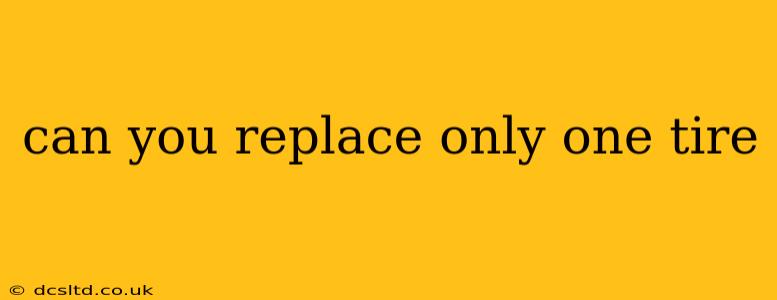Can You Replace Only One Tire?
The short answer is yes, you can replace only one tire. However, there are important considerations to make before doing so, impacting safety, vehicle handling, and the longevity of your tires. This article will explore the circumstances under which replacing a single tire is appropriate and the factors to keep in mind.
Why Would You Only Replace One Tire?
There are several reasons why you might find yourself needing to replace just one tire:
- Accidental Damage: A single tire might suffer a puncture, blowout, or other damage requiring replacement. This is the most common scenario.
- Uneven Wear: While less frequent, one tire might wear out significantly faster than the others due to factors like improper alignment, a mechanical issue, or driving habits. Replacing only this one tire might be a temporary cost-effective solution.
- Spare Tire Use: If you've used your spare tire, you'll naturally need to replace it with a regular tire at some point.
When Replacing One Tire is Not Recommended:
While replacing a single tire is sometimes necessary, it's crucial to understand when it's not ideal:
- Significant Tread Depth Difference: Replacing just one tire when there's a substantial difference in tread depth between it and the others can lead to handling issues and uneven wear on the remaining tires. Ideally, tires with similar tread depth should be on the same axle.
- Different Tire Sizes or Types: Using a tire that's a different size or type than the others can severely impact your vehicle's handling, stability, and potentially damage your drivetrain. Always use tires of the same size, speed rating, and load index as those already on your vehicle.
What to Consider Before Replacing Just One Tire:
- Tire Type and Size: Verify the size and type of tire you need to ensure it's a perfect match for your vehicle and the existing tires. Consult your owner's manual or the sticker on your driver's side doorjamb.
- Tread Depth: Check the tread depth of all your tires. If the difference is significant, it's usually better to replace two tires (on the same axle) for better handling and even wear.
- Tire Condition: Assess the overall condition of your existing tires. If multiple tires are showing signs of wear or damage, it might be more cost-effective and safer to replace them all at once.
- Professional Advice: If you're unsure about whether replacing only one tire is appropriate for your situation, consult a qualified tire professional. They can assess your tires and advise you on the best course of action.
Is it safe to drive on only three matching tires and one spare?
Driving on a spare tire is generally only a temporary solution. Spare tires are often smaller, have different tread patterns, and are designed for limited speed and mileage. While it might be safe for short distances to get to a tire shop, prolonged use can affect your vehicle's handling and stability. Replacing the spare with a matching tire as soon as possible is strongly recommended.
Can I replace just one tire on an AWD or 4WD vehicle?
Replacing only one tire on an all-wheel-drive (AWD) or four-wheel-drive (4WD) vehicle is generally not recommended. The different tire diameters can cause problems with the drivetrain and potentially damage the vehicle's components. It’s best to replace tires in pairs, on the same axle, to maintain proper balance and traction.
By carefully considering these factors, you can make an informed decision about whether replacing just one tire is the right choice for your situation. Remember that safety should always be your top priority. When in doubt, seek professional advice.
